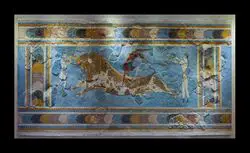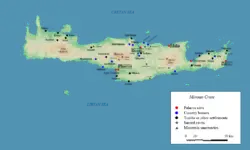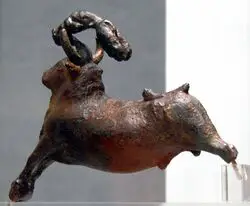Did the Ancient Minoans Play Organized Sports
The Minoans are one of the more mysterious people of the ancient world, largely because they did not leave behind any sizable amount of written texts and what they did write is yet to be deciphered by modern scholars. What is known about the Minoans, though, is that they were the first true civilization of Europe. Besides writing, the Minoans developed long-distance trade with the Egyptians and other peoples of the Bronze Age Near East, built impressive palaces and monuments, and produced beautiful art. The Minoans also influenced the classical Greeks in some ways, one of which may have been through sports and games.
The art and architecture of Bronze Age Crete – the homeland of the Minoan culture – shows that the Minoans engaged in a wide range of sporting and leisure activities, from boxing and wrestling to acrobatics and table games. But most important of all and perhaps the best known today was the “sport” of bull leaping. An examination of ancient Minoan art and architecture reveals that not only did the Minoans participate in a number of different physical activities, but that many of them were probably spectator sports and were quite organized. Questions still remain, though, concerning who was allowed to watch the games and what their primary purposes were.
Minoan Culture and History
In reality, the ancient Minoan culture is a culture with no known name. The name “Minoan” was given to the Bronze Age culture of Crete by British archaeologist Arthur Evans, who discovered the palace of Knossos in 1900. He took the name from classical Greek mythology: King Minos was the mythical ruler of Crete and the man who put the hero Theseus in the Labyrinth with the minotaur. [1] What the Minoans called themselves remains a mystery because their language remains undeciphered. In fact, modern scholars do not know which linguistic family the Minoan language belonged.
As Evans uncovered more sites and discovered many tables of the as of yet undeciphered Linear A script, he was able to place the society into a relatively accurate chronology. The Early Minoan period lasted from about 3000 to 2200 BC and was followed by the Middle Minoan period, which took place from 2200 to 1680 BC. The Late Minoan phase then ended about 1100 BC, when the Bronze Age eastern Mediterranean and Near Eastern systems collapsed. Specialists also subdivide each of the phases into sub-phases.
Most of the major archaeological discoveries from Crete are dated to the Late Minoan, although evidence shows that the Minoans had achieved high culture at the beginning of the Bronze Age. The Minoan culture is often referred to as a “palace culture” because the large settlements on the island were built around and near large palaces. The largest of all the Minoan palace settlements was at Knossos, which was destroyed around 1700 BC and then rebuilt in the early Late Minoan phase. Other major palace settlements were at the southcentral site of Phaistos, Malia, just east of Knossos, and Zakro on the east coast of the island. All palaces were similar to Knossos and suffered major damage and destruction around 1700 BC, although not all were rebuilt. [2]
All of the Minoan palaces were similar in structure and purpose. The palaces were actually large community complexes that combined economic, political, ceremonial, and manufacturing functions for the area. Obviously, the royal living quarters were off limits to the public, but the central court of these complexes were open to some members of the public and were probably where sporting events were held. [3]
The high point of Minoan culture came during the Middle Minoan and early Late Minoan periods. Archaeological evidence shows that the Minoans began colonizing islands in the Aegean Sea, such as Thera and Rhodes, as well as mainland Greece by 2000 BC. [4] Objects from Crete, Egypt, and Mesopotamia show that the Minoans were also engaged in long-distance trade from about 2300 to 1700 BC, but then things began to unravel. [5]
The wars that destroyed most of the palaces around 1700 BC was followed by the eruption of the volcano on Thera around 1500 BC. About a generation after the eruption of Thera, Crete was devastated once again by war, but Knossos still stood until it too was devastated by the Myceneans sometime between 1375 and 1350 BC. [6] Minoan culture may have been destroyed by the end of the Bronze Age, but not before it left its mark on the Greeks and the rest of the ancient world.
Boxing, Wrestling, Pankration, and Other Activities in Ancient Crete
A number of archaeological and architectural objects from Crete reveal that the Minoans enjoyed a wide range of athletic and leisure activities. Most of the objects are dated to the Late Minoan phase, with one of the most interesting being the so-called “Boxer Vase” from Hagia Triadha.
Dated to around 1550 BC, the vase shows different athletic activities on four separate registers. The first register shows two men boxing with a column separating them from three other men who also appear engaged in a combat sport. The second register depicts a bull leaping event, while the fourth register shows four helmeted men with forearm guards and padded hands. Two of the men are upright and two are on the ground. The fourth register shows men with no helmets, but wrapped wrists, possibly holding daggers or “brass knuckles.” One of the men has clearly been thrown to the ground, which would suggest a wrestling or pankration match. Donald Kyle believes that there is a possibility that the vase should be read sequentially as different events at a festival. [7] Like the later Greek games, or even the Roman spectacles, there would have been breaks between the events where refreshments would have been served and spectators could have been able to take care of other things. There may also have been more events at Minoan festivals that are not depicted on the Boxer Vase.
Images of acrobats and dancers on gemstones and figurines points to the Minoans engaging in less violent physical activities and a damage fresco from about 1500 BC, known as the “Grandstand Fresco,” depicts spectators watching some type of activity in an open area of the Knossos palace. [8] It is possible that acrobatic and choral dancing took place between the combat events and before the festival’s main event.
Minoan Bull Leaping
There is little doubt that among Minoan sports and activities bull leaping was the most important and probably the most popular. Images of bull leaping are found on frescoes, such as the restored “Toreador Fresco” from Knossos, and several small statues and amulets. Modern scholars are in consensus that the events took place, but there is disagreement over the details: where they took place, who participated, who spectated, and what was their significance. An examination of the major Minoan palaces on Crete may help answer some of these questions.
The Toreador Fresco and other bull leaping frescos at Knossos were located on the walls of the north and west entrances to the palace. [9] The most famous of these is the Toreador Fresco, which apparently shows three men wrestling with a bull in different positions, although many scholars now believe that the fresco actually shows three stages of a successful bull leap going from left to right. [10] Since the frescoes are located in the palace, most scholars believe that is where the events were held, presumably in the large central court.
For bull leaping events to be held in the Minoan palace complexes, the palace would have needed to meet five conditions: a safe viewing area for spectators, access to the central court without having to lead the bulls through the interior of the palace, pens for the bulls, a system that kept the bulls confined to the central court during the event, and possibly a vaulting device to leap over the bulls. During his work at the Minoan sites of Knossos, Milia, Zakro, and Phaistos, James Thompson believes he identified most of the conditions at all five sites, although he did not identify a leading system at Phaistos. [11]
Although some scholars have suggested that bull leaping events were held somewhere off the palace grounds, excavations have turned up no evidence of stadiums or arenas outside of the palaces. Some of the extant bull leaping frescoes show a two story structure and the Boxer Vase also indicates that the events were done inside. [12] The argument against bull leaping events taking place inside the palaces focus on an inability to control the bulls and a lack of seating for spectators. Excavations at most of the major palace sites have uncovered footings for what were possibly temporary walls and partitions that were erected to move the bulls safely from pens through the palace to the central court. The spectators would have then watched the events from the second floor of the palace. [13]
The bulls could have been kept either in what were possibly pens below the palace [14] or in another location and herded in through the temporary partitions. The number of spectators at a bull leaping event would probably have been contingent on the setting and purpose of the event.
Based on the ubiquitous nature of bull images in Minoan art, many scholars believe that the bull leaping events had a religious element to them. Some scholars believe that after “taming” the bulls in a combined athletic event and religious ritual, the bulls were then sacrificed and consumed. [15] Since the bull leaping sport was probably done in the palace and more than likely connected to religion, it would stand to reason that the number of spectators would have been small and they would have been of the elite. [16] Perhaps the biggest question of Minoan sports that remains unsolved, though, is who were the athletes: were they professionals, slaves, or members of the elite?
Conclusion
An examination of the primary source evidence reveals that the ancient Minoans took part in a wide variety of athletic and sporting events, some of which may have been adopted by the Greeks. It appears that Minoan sports were highly organized and usually conducted in the central courts of their major palaces. The evidence also shows, at least in the case of bull leaping, that the events had a religious significance and therefore, along with the locations, the events were limited to certain spectators.
References
- Jump up ↑ Hood, Sinclair. The Minoans: Crete in the Bronze Age. (London: Thames and Hudson, 1971), p. 155
- Jump up ↑ Hood, p. 36
- Jump up ↑ Preziosi, Donald and Louise A. Hitchcock. Aegean Art and Architecture. (Oxford: Oxford University Press, 1999), pgs. 64-65
- Jump up ↑ Hood, p. 52
- Jump up ↑ Hood, p. 124
- Jump up ↑ Hood, pgs. 57-60
- Jump up ↑ Kyle, Donald G. Sport and Spectacle in the Ancient World. (Malden, Massachusetts: Blackwell, 2007), p. 40
- Jump up ↑ Kyle, p. 39
- Jump up ↑ Hood, p. 80
- Jump up ↑ Kyle, p. 41
- Jump up ↑ Thompson, James G. “Clues to the Location of Bull Jumping at Zakro.” Journal of Sports History 19 (1992) pgs. 62-63
- Jump up ↑ Thompson, James G. “The Location of Minoan Bull-Sports: A Consideration of the Problem” Journal of Sports History 13 (1986) p. 8
- Jump up ↑ Thompson, 1986, p. 12
- Jump up ↑ Thompson, James G. “Clues to the Location of Minoan Bull-Jumping from the Palace of Knossos.” Journal of Sports History 16 (1989) pgs. 62-63
- Jump up ↑ Hood, p. 89
- Jump up ↑ Marinatos, Nannó. “The ‘Export’ Significance of Minoan Bull Hunting and Bull Leaping Scenes.” Ägypten und Levante/Egypt and the Levant 4 (1994) p. 93


